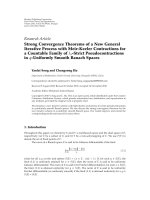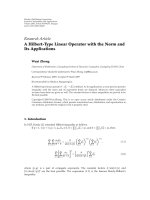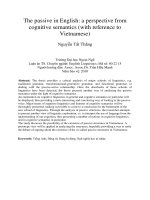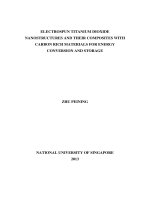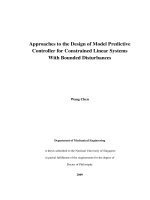A CMOS DB linear VGA with DC offset cancellation for direct conversion receiver
Bạn đang xem bản rút gọn của tài liệu. Xem và tải ngay bản đầy đủ của tài liệu tại đây (1.15 MB, 106 trang )
A CMOS DB-LINEAR VGA WITH DC OFFSET
CANCELLATION FOR DIRECT-CONVERSION
RECEIVER
YAN JIANGNAN
(B.Eng. ZJU)
A THESIS SUBMITTED FOR THE DEGREE OF MASTER OF
ENGINEERING DAPARTEMNT OF ELECTRICAL &
COMPUTER ENGINEERING
NATIONAL UNIVERSITY OF SINGAPORE
2005
A CMOS DB-LINEAR VGA WITH DC OFFSET
CANCELLATION FOR DIRECT-CONVERSION
RECEIVER
YAN JIANGNAN
NATIONAL UNIVERSITY OF SINGAPORE
2005
Name: YAN JIANGNAN
Degree: Master of Engineering
Dept: Electrical & Computer Engineering, NUS
Thesis Title: A CMOS dB-Linear VGA with DC offset cancellation for
direct-conversion receiver
Abstract
In this thesis, a CMOS dB-linear variable gain amplifier (VGA) with a novel
I/Q tuning loop to remove DC offset for direct-conversion receiver has been
designed in a 0.35µm CMOS technology.
The dB-linear VGA comprises a linear VGA and a novel pseudo-exponential
voltage circuit. Different VGA and pseudo-exponential circuit have been studied.
The proposed circuit is a differential source degenerated VGA and a Taylor’s
series expansion based pseudo-exponential voltage circuit, which has been
designed, simulated, and tested.
Different DC offset cancellation methods have been investigated and a novel
I/Q tuning loop is presented. DC offset sense issues have been discussed and
solutions are presented. Block level simulation, circuit level simulation and
measurement result are explained.
This dB-linear VGA provides a variable gain of 60dB while maintaining its 3
dB bandwidth greater than 2.5 MHz. DC offset rejection is 50 dB. The overall
IIP3 and IIP2 is 12.165dBm and 40.7dBm, respectively.
Keywords: dB-linear, DC offset cancellation, I/Q mismatch, I/Q tuning loop,
Pre-distortion compensation, VGA
i
Acknowledgements
I would like to express my deepest gratitude to my supervisor, Dr. Zheng
Yuanjin, for the opportunity to work on an interesting research topic and his
encouragement, guidance and many invaluable ideas during the research. I am
also extremely grateful to my associate supervisor, Assoc. Prof Xu Yong Ping, for
his guidance and patience. His invaluable comments has made breakthrough to the
whole research project.
I would also like to take this opportunity to thank the Institute of
Microelectronics for the award of a research scholarship under Joint
Microelectronics Laboratory with National University of Singapore and Integrated
Circuits and System Lab for providing excellent facilities, without which the
present work would not have been possible. Thanks also goes to the National
University of Singapore for giving me the opportunity to pursue postgraduate
study.
I am grateful to Mr. Wong Sheng Jau, Mr. Teo Tee Hui, and Mr. Oh Boon
Hwee for their numerous extended discussions, clear thoughts and generous
assistance provided throughout the project.
ii
I want to express my gratitude to all my present and former colleagues at the
NUS laboratory for creating a relaxed and pleasant working atmosphere.
I wish to thank my friends who are working together with me in IME. Their
help and contributions to the relaxed, humorous, and inspiring team spirit have
been essential for this work.
Finally, I should acknowledge my family members. They showed so much
concern and care about me during the course of my study. Especially I want take
this opportunity to thank my dearest Yangxi. Not only for his encouragement and
constant support contributed to the completion of this project, but also for he
giving me such a wonderful life.
iii
Contents
Acknowledgements……………………………………………………………… i
Contents iii
Summary…… vi
List of Tables… viii
List of Figures…… ix
List of Symbols & Abbreviations xii
Chapter 1 Introduction 1
1.1 Background and motivation 1
1.2 Thesis organization 3
Chapter 2 Literature Review 5
2.1 Direct-conversion receivers 5
2.1.1 Architecture of Direct-conversion receivers 5
2.1.2 Merits and design issues of DCRs 7
2.2 dB-linear VGA 7
2.2.1 Linear VGA 9
2.2.2 Pseudo-exponential circuit 11
2.3 DC offset cancellation 14
iv
2.3.1 Degeneration and impact of DC offset 14
2.3.2 DC cancellation review 16
Chapter 3 Receiver System Configuration 21
Chapter 4 A novel CMOS dB-Linear VGA 25
4.1 Differential linear variable gain amplifier 25
4.2 Exponential function generation circuit 27
4.3 dB linearity compensation 29
4.3.1 Compensation for nonzero source voltage and the threshold voltage
of the degeneration transistor 30
4.3.2 Compensation for the increased transconductance 32
4.4 Simulation results for dB-linear VGA 33
Chapter 5 A novel DC Offset Cancellation Circuit 36
5.1 Buffer in the tuning circuit 37
5.2 Tuning loop configuration 38
5.3 DC offset detection issues 41
5.4 I/Q Mismatch Issues 44
5.5 Circuit Implementation 45
5.5.1 Multiplier 45
5.5.2 Low Pass Filter 46
5.5.3 Integrator and V-I convertor 47
5.5.4 Comparator 49
5.5.5 Limiter and summation block 50
v
5.6 Adaptive Bandwidth Varying 52
5.7 Large signal analysis (Transient Analysis) 54
5.7.1 Large signal analysis derivation 54
5.7.2 MATLAB simulation for large signal analysis 56
5.8 Small signal analysis (Steady state analysis) 59
5.9 Simulation Results 62
Chapter 6 Measurement Results 65
Chapter 7 Conclusion and Recommendation 72
Bibliography……………………………………………………………………xviii
Appendix A Layout of the VGA chip xxvii
Appendix B Die Photo xxviii
Appendix C Publications xxix
vi
Summary
In this thesis, a CMOS dB-linear variable gain amplifier (VGA) with a novel
DC offset cancellation scheme for direct-conversion receiver has been described.
The dB-linear VGA comprises a linear VGA and a newly proposed
pseudo-exponential voltage circuit. Different VGA and pseudo-exponential circuit
have been studied. From the requirement in DCRs, the proposed circuit is a
differential source degenerated VGA and a Taylor’s series expansion based
pseudo-exponential voltage circuit, which has been designed, simulated, and
tested.
Among all the mentioned inherited problems with direct conversion, DC offset
may be the most severe problem. Therefore, DC offset cancellation is
indispensable in zero-IF circuit of DCR. Different DC offset cancellation methods
have been investigated and a novel I/Q tuning loop is presented. DC offset sense
issues have been discussed and solutions are presented. System level simulation,
circuit level simulation and measurement result are explained.
In summary, the CMOS dB-linear VGA provides a variable gain of 60dB
while maintaining its 3 dB bandwidth larger than 2.5 MHz. non-ideal effects on
vii
dB linearity are analyzed and the corresponding compensation methods are
suggested. The proposed I/Q tuning loop is proved to be effective in removing DC
offset and can suppress I/Q mismatch effects simultaneously. Measurement results
based on 0.35-µm CMOS technology are presented to demonstrate the good
linearity of the proposed dB-linear VGA and shows that the DC offset cancellation
loop can remove DC offset efficiently.
viii
List of Tables
Table 1 Specifications of proposed VGA 24
Table 2 Decision for tuning direction 42
Table 3 Measurement results 71
ix
List of Figures
Fig.2.1 Direct-conversion Principle and downconverted spectrum 6
Fig.2.2 Mechanism of DC offset generation 16
Fig.2.3 AC coupling for DC-cancellation 17
Fig.2.4 Feedback DAC system 18
Fig.2.5 Feedback configuration to cancel DC offset. (a) Conceptual diagram.
(b) Frequency response 20
Fig.3.1 System Diagram 22
Fig.4.1 One stage of the differential linear VGA 26
Fig.4.2 Pseudo-exponential voltage circuit 29
Fig.4.3 Pseudo-exponential voltage circuit with compensation techniques 33
Fig.4.4 Simulation result of the exponential circuit 34
Fig.4.5 Simulation result of the gain of VGA 35
Fig.5.1 DC offset cancellation Circuit 36
Fig.5.2 The unity gain buffer 37
Fig.5.3 DC offset behavior in the buffer 38
Fig.5.4 Diagram of Tuning Loop 39
Fig.5.5 DC offset behavior in the DC offset cancellation circuit 39
x
Fig.5.6 Polarity Decision Branch 43
Fig.5.7 Entire Diagram of the Tuning Loop 45
Fig.5.8 Schematic of the Multiplier 46
Fig.5.9 Schematic of the LPF 47
Fig.5.10 Schematic of Integrator 48
Fig.5.11 Schematic of the V-I converter 48
Fig.5.12 Schematic of Comparator 50
Fig.5.13 Schematic of Limiter 51
Fig.5.14 Schematic of the summation block 52
Fig.5.15 Implementation of Bandwidth varying 54
Fig.5.16 Equivalent model of the integrator and LPF 55
Fig.5.17 MATLAB Simulation of DC offset tuning for combination tuning
scheme to suppress I/Q mismatch effect 57
Fig.5.18 MATLAB Simulation of DC offset tuning for varying bandwidth and
fixed bandwidth 58
Fig.5.19 MATLAB Simulation of DC offset tuning for I, Q DC offset with
different polarity 58
Fig.5.20 Linearized model of DC offset tuning loop 59
Fig.5.21 Cadence Simulation Results for DC offset tuning circuit 63
Fig.5.22 Cadence Simulation Results for DC offset tuning circuit under I/Q
mismatch 63
Fig.5.23 Cadence Simulation Results for Varying bandwidth DC offset tuning
circuit under I/Q mismatch 64
Fig.5.24 Tuning process of the DC offset with varying bandwidth under I/Q
mismatch 64
xi
Fig.6.1 Frequency Response of the VGA System 66
Fig.6.2 Two tone test of the VGA 67
Fig.6.3 Test result of Exponential Voltage 68
Fig.6.4 Test result of dB linear 69
Fig.6.5 Output DC offset of the VGA 71
xii
List of Symbols & Abbreviations
Symbols
a, b Constants
A Loop gain
A
v
Voltage Gain
C
I,int
Capacitance of integrator of I path
C
L
Load capacitance
C
LPF
Capacitance used for low pass filter
C
ox
Gate oxide capacitance per unit area
C
Q,int
Capacitance of integrator of Q path
e
Error voltage between DC offset and feedback
tuning voltage
g
b
Equivalent transconductance of the V-I converter
g
m
Transconductance of the input transistor
G
s
Transconductance of the source degeneration
I
0
Bias current of the current square circuit
I
b
Bias current
I
bias
Bias current
xiii
I
CS
Constant current
I
CM1
Compensation current
I
fI
Feedback current of I path
I
fQ
Feedback current of Q path
I
in
Input current
I
out
Output current
I
VI
Output current of V-I convertor
k
1I
Amplifying weight for I path signal
k
1Q
Amplifying weight for I path signal
k
2
Amplifying weight for multiplied signal
k
b
Current mirror scale
k
inte
Amplifying coefficient of integrator
k
l
Amplifying coefficient of limiter
k
m
Amplifying coefficient of multiplier
L Length of the transistor
M Transistor
PI Tuning direction of I path
PQ Tuning direction of Q path
R Resistor
R
1I
Equivalent output resistance of the low pass filter in
I path
R
1Q
Equivalent output resistance of the low pass filter in
Q path
xiv
R
d
Load resistor
R
e
Resistor to generate exponential voltage
R
I
Output resistance of the buffer of I path
R
L
Load resistance
R
LPF
Equivalent output resistance of the low pass filter
R
Q
Output resistance of the buffer of Q path
s Laplacian
sign(·) Polarity
U Product of DC offset of I path and Q path
V
0
Input of the varying bandwidth circuit
V
1
Signal amplitude after the low pass filter
V
1I
Output signal amplitude of I path low pass filter for
polarity
V
1Q
Output signal amplitude of Q path low pass filter for
polarity
V
c
DC voltage
V
ctrl
Gain control voltage
'
Ctrl
V
Gain control voltage after pre-distortion
compensation
V
dc
DC offset
V
dcI
DC offset of I path
V
dcQ
DC offset of Q path
vdd Voltage supply
xv
V
f
Feedback voltage
V
high
High voltage level of limiter
V
I
Total signal of I path
V
low
Low voltage level of limiter
V
m
Output of the multiplier
V
g
Gate voltage
V
gs
Gate-source voltage
c
in
V
Input voltage of the pseudo-exponential voltage
circuit to generate gain control voltage
V
in1
The first input
V
in2
The second input
V
inI
Input signal of I path
V
inQ
Input signal of Q path
V
inte
Output of integrator
V
out
Output voltage
V
Q
Total signal of Q path
V
s
Source voltage
V
st
Sum of source voltage and threshold voltage
V
sum
Sum voltage signal
V
th
Threshold voltage
W Width of the transistor
x Independent variable
xvi
Y
1I
Transconductance of the input transistor of the low
pass filter for polarity deciecion in I path
Y
1Q
Transconductance of the input transistor of the low
pass filter for polarity deciecion in I path
Y
I,int
Equivalent transconductance of the integrator of I
path
Y
I-VI
Equivalent transconductance of the V-I converter of
I path
Y
LPF
Transconductance of the input transistor of the low
pass filter
Y
Q,int
Equivalent transconductance of the integrator of I
path
Y
Q-VI
Equivalent transconductance of the V-I converter of
IQ path
Z Ac components of the output signal of multiplier
ω
LPF
Bandwidth of the low pass filter
µ
n
The mobility of electron
λ Channel length modulation coefficient
Abbreviations
ADC Analog-to-Digital Converter
AGC Automatically Gain Control
BER Bit error rate
BiCMOS Bipolar Complementary Metal Oxide Semiconductor
CDMA Code division multiple access
CMFB Common-mode feedback
xvii
CMOS Complementary Metal Oxide Semiconductor
CMRR Common-mode rejection ratio
CSC Current Square Circuit
DC Direct Current
DCR Direct Conversion Receiver
DSB Double sideband
DSP Digital Signal Processing
ESD Electrostatic discharge
FSK Frequency shift keying
GSM, GSM900 Global system for mobile communications
HPF High Pass Filter
IC Integrated Circuit
IF Intermediate Frequency
IIP2 Second-order input intercept point
IIP3 Third-order input intercept point
IS-95 Interim standard 95
ISI Inter-Symbol Interference
LNA Low noise amplifier
LO Local Oscillator
MOS Metal oxide semiconductor
MOSFET Metal oxide semiconductor field effect transistor
NF noise figure
xviii
NMOS N-channel metal oxide semiconductor
PCB Printed circuit board
PGA Programmable-gain amplifier
PMOS P-channel metal oxide semiconductor
PTAT Proportional to absolute temperature
QPSK Quadrature Phase Shift Keying
RF Radio Frequency
SNR Signal-to-noise ratio
SSB Single sideband
SAW Surface Acoustic Wave
TDMA Time division multiple access
THD Total harmonic distortion
VGA Variable Gain Amplifier
WCDMA Wide-band code division multiple access
WLAN Wireless Local Area Network
1
Chapter 1
Introduction
1.1 Background and motivation
The evolution of current wireless communication systems has been very rapid.
Complexity, cost, power dissipation, and the number of external components have
been the primary criteria in selecting receiver architecture. While transistor
technology scaling and improved circuit techniques will contribute evolutionary
advances towards this goal, architectural innovations in the transceiver may lead
to revolutionary improvements. It is in this context that there is a resurgence of
interest in Direct-Conversion. Although superheterodyne used to be employed
commonly in wireless communication receivers for a long time, direct frequency
conversion has emerged over the last six years as the de-facto standard for GSM
handset design. Among the handset manufacturers currently using direct
conversion architectures are Alcatel, nokia, Ericsson, Samsung, Siemens to name
a few. Also, several RFIC suppliers (Infineon, Conexant, Analog Devices, Phillips,
Qualcomm, TI, etc.) are currently offering standard direct conversion chipsets for
1.1 Background and motivation
2
GSM handsets and have started to offer the same for WCDMA and CDMA
systems.
Variable Gain amplifier is an important block in the base-band circuit in the
DCR architecture. A VGA is typically used in a feedback loop to realize the AGC
circuit. The demand of an automatic gain control (AGC) loop in wireless system
comes from the fact that all communication systems have an unpredictable
received power. To buffer receiver electronics from change in input signal strength
by producing a known output voltage magnitude, an AGC loop is indispensable in
DCRs [1]. Therefore, with a VGA, dynamic range of the overall system is greatly
improved. To maintain AGC loop settling time which is independent from the
signal levels, an exponential gain control characteristic is required [1]. A VGA
should meet requirements of large dynamic range and good dB linearity. And for
DCR applications, it has to be able to efficiently suppress DC offset.
DC offset is a severe problem in DCRs. DC offset comes from device
mismatch and local oscillator leakage. Since device mismatch and local oscillator
leakage always exist, DC offset is an inherent problem of DCRs. Because in a
direct-conversion receiver the down converted band extend to zero frequency,
extraneous offset voltages can corrupt the signal and, more importantly, saturate
the following stages [2]. Therefore, offset cancellation methods are necessary in
DCRs. An extensive review of DC offset cancellation methods is given in 2.2, and
the drawback of these methods is analyzed. Currently, DC offset cancellation is
still a demanding task in DCRs and more research needs to be done.
1.2 Organization of this Thesis
3
In this thesis, a CMOS dB-linear variable gain amplifier (VGA) with a novel
I/Q tuning loop for DC offset cancellation for direct-conversion receiver has been
designed in a 0.35µm CMOS technology. With some minor modification, this
proposed VGA can be used for different applications in wireless communication,
such as WLAN, WCDMA.
1.2 Thesis organization
In Chapter 2, a comprehensive review of DCRs, VGAs, and DC offset
cancellation solutions is given. Basic architecture of DCR is described and its
advantages and challenges are studied. Previously reported methods of
implementing dB-linear VGA and DC offset cancellation circuits have been
investigated.
In Chapter 3, the system configuration of the proposed VGA circuit is
described. Also, an introduction to the VGA circuit requirements is given. These
requirements depend on the system specifications, receiver architecture, and
receiver partitioning.
Chapter 4 concentrates on the design of the dB-linear VGA. First a linear
VGA is described. Then a novel exponential voltage generator is proposed to
obtain the dB-linear control characteristics. Next the non-ideal effects on dB
linearity are analyzed and the corresponding compensation methods are suggested.
At last simulation result is shown.
1.2 Organization of This Thesis
4
Chapter 5 describes a novel DC offset cancellation circuit for DCR. The
proposed structure uses an I/Q tuning loop to remove DC offset. I/Q mismatch
issue is discussed and the solution to suppress I/Q mismatch effects is adopted. A
variable bandwidth technique is employed to accelerate the loop acquisition when
the system is first time turned on. Moreover, a tuning scheme is adopted to
efficiently suppress effects of I/Q mismatch. At last simulation results based on
block level and circuit level is shown.
Chapter 6 describes the experimental result to demonstrate the effectiveness of
the pre-distortion techniques and the DC offset tuning loop.



